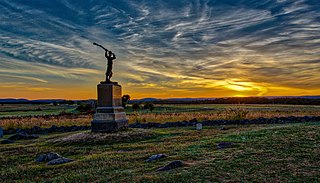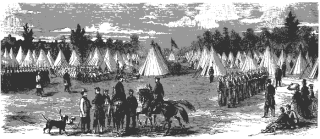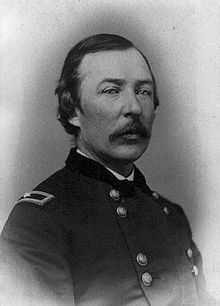The Irish Brigade was an infantry brigade, consisting predominantly of Irish Americans, who served in the Union Army in the American Civil War. The designation of the first regiment in the brigade, the 69th New York Infantry, or the "Fighting 69th," continued in later wars. The Irish Brigade was known in part for its famous war cry, the "Faugh a Ballaugh" which is an anglicization of the Irish phrase, fág an bealach, meaning "clear the way" and used in various Irish-majority military units founded due to the Irish diaspora. According to Fox's Regimental Losses, of all Union army brigades, only the 1st Vermont Brigade and Iron Brigade suffered more combat dead than the Irish Brigade during America's Civil War.

The 69th Infantry Regiment is an infantry regiment of the United States Army. It is from New York City, part of the New York Army National Guard. It is known as the "Fighting Sixty-Ninth", a name said to have been given by Robert E. Lee during the Civil War. An Irish-American heritage is attributed to the regiment, which is also nicknamed the "Fighting Irish" – a tradition mentioned in Joyce Kilmer's poem "When the 69th Comes Back". Between 1917 and 1992 it was also designated the 165th Infantry Regiment. It is headquartered at the 69th Regiment Armory in Manhattan.

California's involvement in the American Civil War included sending gold east to support the war effort, recruiting volunteer combat units to replace regular U.S. Army units sent east, in the area west of the Rocky Mountains, maintaining and building numerous camps and fortifications, suppressing secessionist activity and securing the New Mexico Territory against the Confederacy. The State of California did not send its units east, but many citizens traveled east and joined the Union Army there, some of whom became famous.

The 71st Regiment, Pennsylvania Volunteer Infantry was an infantry regiment of the Union Army that participated in the American Civil War.
The Philadelphia Brigade was a Union Army brigade that served in the American Civil War. It was raised primarily in the city of Philadelphia, Pennsylvania, with the exception of the 106th regiment which contained men from Lycoming and Bradford counties.

The 72nd Pennsylvania Infantry was a volunteer infantry regiment which served in the Union Army during the American Civil War. It was part of the famous Philadelphia Brigade.

The 118th Pennsylvania Regiment was a volunteer infantry regiment in the Union Army during the American Civil War. They participated in several major conflicts during the war including the Battle of Gettysburg, Siege of Petersburg, and escorted the truce flag of Robert E. Lee at the Battle of Five Forks. The regiment was led by Colonel Charles Prevost until he was seriously injured at the Battle of Shepherdstown in which Lieutenant-Colonel James Gwyn assumed command until the end of the war.

During the American Civil War, Philadelphia was an important source of troops, money, weapons, medical care, and supplies for the Union.

The 59th New York Infantry Regiment was a regiment in the Union Army during the American Civil War. As part of the Second Corps of the Army of the Potomac, it played a significant role in battles such as Antietam and Gettysburg.

The 11th New York Infantry Regiment was an infantry regiment of the Union Army in the early years of the American Civil War. The regiment was organized in New York City in May 1861 as a Zouave regiment, known for its unusual dress and drill style, by Colonel Elmer E. Ellsworth, a personal friend of U.S. President Abraham Lincoln. Drawn from the ranks of the city's many volunteer fire companies, the unit was known alternately as the Ellsworth Zouaves, First Fire Zouaves, First Regiment New York Zouaves, and U.S. National Guards.

Jacob Gellert Frick Sr. was a United States infantry officer who fought with several Union Army regiments during the American Civil War, including as lieutenant colonel of the 96th Pennsylvania Infantry and as colonel of the 129th Pennsylvania Infantry. He received his nation's highest award for valor, the U.S. Medal of Honor, for his gallantry during the battles of Fredericksburg and Chancellorsville, Virginia. Grabbing the American flag from his regiment's color-bearer at Fredericksburg on December 13, 1862, he inspired his men to move forward "through a terrible fire of cannon and musketry"; at Chancellorsville, he personally engaged in hand-to-hand combat on May 3, 1863, to retrieve his regiment's flag which had been captured by the enemy. He was 67 years old when his Medal of Honor was conferred on June 7, 1892.

The 19th Virginia Infantry Regiment was an infantry regiment raised in Virginia for service in the Confederate States Army during the American Civil War. It fought mostly with the Army of Northern Virginia.

Charles McAnally was a native of Glenviggan, County Londonderry, Ireland who served with the federal army of the United States during the American Civil War. Severely wounded in action while fighting as a first lieutenant with Company D of the 69th Pennsylvania Infantry at Spottsylvania, Virginia, on May 12, 1864, he captured the flag of the enemy during hand-to-hand combat with Confederate States Army soldiers, and was subsequently awarded the United States' highest commendation for valor, the Medal of Honor, on October 15, 1872.
Irish-American Catholics served on both sides of the American Civil War (1861–1865) as officers, volunteers and draftees. Immigration due to the Irish Great Famine (1845–1852) had provided many thousands of men as potential recruits although issues of race, religion, pacifism and personal allegiance created some resistance to service. A significant body of these veterans later used the military experience gained in the war to launch several conflicts with the goal of establishing an independent Irish Republic as members of the Irish Republican Brotherhood, the Fenian Brotherhood and Clan na Gael.

The 91st Pennsylvania Volunteer Infantry was a Union infantry regiment which fought in multiple key engagements of the American Civil War, including the Battle of Fredericksburg, Battle of Chancellorsville and Battle of Gettysburg. It was established through the combined efforts of Edgar M. Gregory, who had received approval from the U.S. War Department to begin recruiting soldiers for an entirely new regiment during the fall of 1861, and Edward E. Wallace, who had initiated his own recruitment efforts that October. Their recruits were volunteers, the majority of whom initially enlisted for three-year terms of service from their hometown of Philadelphia; they were divided into 10 lettered companies upon muster in during early December 1861: A, B, C, D, E, F, G, H, I, and K.

Charles Henry Tucker "Tucky" Collis was an Irish-American US Army officer who received the Medal of Honor for his actions in the American Civil War.
The following list is a Bibliography of American Civil War Union military unit histories. More details on each book are available at WorldCat.
The 2nd Delaware Infantry Regiment was an infantry regiment in the Union Army during the American Civil War.

The 47th Pennsylvania Infantry Regiment, officially the 47th Regiment, Pennsylvania Volunteer Infantry and sometimes referred to simply as the 47th Pennsylvania Volunteers, was an infantry regiment that served in the Union Army during the American Civil War and the early months of the Reconstruction era. It was formed by adults and teenagers from small towns and larger metropolitan areas in central, northeastern, and southeastern regions of Pennsylvania.

Richard Henry Rush was an American military officer who served in the United States Army during the Mexican-American War and the Union Army during the American Civil War. He mustered and served as colonel in the 6th Pennsylvania Cavalry Regiment from October 1861 to September 1862.


















